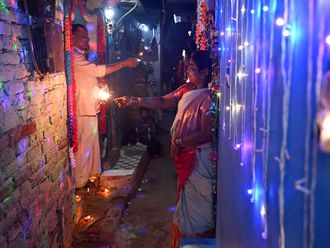Kolkata: The Wildlife authorities in West Bengal are setting up a special reserve for old tigers no longer able to hunt. The move is part of a country-wide campaign to revive India's rapidly falling tiger population by keeping the highly endangered national animal away from poachers and from conflicts with angry villagers, who sometimes kill them.
West Bengal's principal chief conservator of forests Atanu Kumar Raha said that the tigers that could no longer catch prey because of their age or infirmity would be rescued and then be relocated to the centre.
"It is going to be like an old-age home for the tigers. We are developing it almost like a natural habitat for them. It is definitely not to be something like a zoo. The animals here will feel free almost as they do in the wild. They will be fed well and will be provided veterinary care," said Raha.
"The facility will also remain open for old or sick tigers from the zoos in the country. For wild tigers, in certain circumstances, it will also be used like a short stay home."
The reserve which will be known as Tiger Rescue Centre is coming up at the edge of the world's largest mangrove forests of Sundarbans, about 140 kilometres south of Kolkata. Built over a five-acre plot, it will house tigers from the country's wildlife reserves as well as the zoos.
Wildlife officials said this week that the construction of the centre near Jharkhali village in the Sundarbans delta began last December and it will be ready for use before this year ends.
Seven 15 metre x 15 metre cages are being readied for the tigers at the centre. Each cage will have access to a fenced land of around 900 square metres where a tiger could roam. Two tigers from the zoo in Kolkata are already in the queue, awaiting to be rehabilitated at the rescue centre.
District Forest Officer of 24 Paraganas (South) Shubhendu Bandopadhya said that hungry, old and sick tigers, unable to hunt inside the Sundarbans Tiger Reserve [STR], often stray out of the forest and target cattle in the villages.
Danger to villagers
"For long years it has been a practice to capture the stray tigers, after tranquillising them, and release them back in the forest. But in search of easier prey the same tigers sometimes stray out of forest again. Now [after the centre becomes operational], we shall be able to rehabilitate such tigers at the centre and minimise the chances of the animals' conflicts with the villagers," said Bandopadhyaya.
"Sometimes we happen to rescue tigers that get injured in fight with other tigers or animals. Injured tigers will be taken to the centre where they will be treated as long as needed, before being released back into the wild. Those unable to hunt any longer will be rehabilitated in the centre permanently."
Another wildlife official in Sundarbans Tiger Reserve said that the rescue centre which will have high walls surrounding it would also be used to help pregnant tigers deliver their cubs.
"Male tigers occasionally attack and kill just-born tiger cubs inside the forests. So, pregnant female tigers sometimes — while seeking safer places to give birth to their cubs — end up straying into villages. Every year we rescue some pregnant tigers in such situation and release them back in the forest," said the official. "After our rescue centre becomes operational, stray pregnant tigers could be rescued from outside forests and taken to the centre where they can deliver [their cubs] safely. When the cubs grow up they could be relocated from the centre to the deep of the forest."
At the centre, beef, mutton and pork will be provided for the tigers, the officer added.
India's wild-tiger population has dwindled rapidly in recent years, prompting an international outcry among conservationists. About 25 years ago it was estimated that India had 4,000 tigers- amounting to 40 per cent of the world's tiger population then. International communities urged India to take concrete steps to save India's tigers.
Later, targeting to save the country's national animal from extinction, India took some steps as suggested by the conservationists. In a significant initiative, India's prime minister also set up a special tiger task force in 2005. Yet, the population of the big cats has kept on dwindling.
From an estimated 40,000 of the big cats a century ago, the population of India's national animal is now 1,706, according to the latest national tiger census report released in March by the India's National Tiger Conservation Authority [NTCA].
Poachers
According to the NGO Wildlife Protection Society of India, at least 30 tigers were killed by poachers in India in 2010, and 28 others died naturally.
In the STR or the Indian part of the Sundarbans forest — which is internationally identified by the conservationists as a showcase tiger reserve, the population of Royal Bengal tigers has dropped to 70 — down from 274 in 2004, according to the latest NTCA census.
Wildlife officials in West Bengal hope the centre will help stabilise the tiger population in the region.
This week the West Bengal government officials said that when the tiger rescue centre becomes operational and begins receiving tigers, it will be a major centre of attraction for local and international tourists.
"After news of the tiger rescue centre were broadcast over national TV channels , every week our offices in Kolkata and Sundarbans are receiving many queries with people across the country asking when the centre will be ready or opened to tourists," said West Bengal forest minister Hitesh Barman.
"Otter and crocodile breeding centres are also to come up around the tiger rescue centre soon. We have a plan to develop the area as a major tourist hub."
- 900 land in square metres where tigers can roam
- 4,000 tiger population in India about 25 years ago
- 1,706 tigers in India, according to census figures
- 30 tigers killed by poachers in 2010












